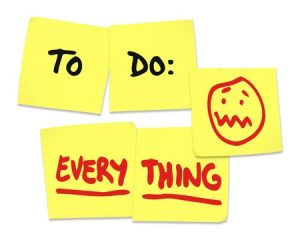Have you ever felt like you’re responsible for completing an impossible to-do list? Who hasn’t, right?
 I can vividly remember one day earlier this year when I attempted to type a list of all of the things (both personally and professionally) that I wanted to accomplish every day. I still have the list… it has 15 items. As a number, 15 doesn’t really seem like that many. But, these weren’t everyday obvious things. The words on my list weren’t brush teeth, pay bills, empty Inbox, or feed kids. Next to each check box were phrases like learn something new, show gratitude, spend quality time with family. Maybe this list could reasonably be accomplished each day, except one of the items was “sleep 6 + hrs. /night”. Ugh!! So much for best laid plans.
I can vividly remember one day earlier this year when I attempted to type a list of all of the things (both personally and professionally) that I wanted to accomplish every day. I still have the list… it has 15 items. As a number, 15 doesn’t really seem like that many. But, these weren’t everyday obvious things. The words on my list weren’t brush teeth, pay bills, empty Inbox, or feed kids. Next to each check box were phrases like learn something new, show gratitude, spend quality time with family. Maybe this list could reasonably be accomplished each day, except one of the items was “sleep 6 + hrs. /night”. Ugh!! So much for best laid plans.
I labeled this “My Impossible To-do List”, filed it away, and moved on with my day. I had good intentions, but just typing up the list was overwhelming.
I heard a similar reaction from a Sustainability Coordinator when I asked for her feedback on a previous blog post. She commented, “We have so many issues to work on and are just waiting for the next demand on growers… soil, water use, water quality, climate, pollinators, monarchs, sourcing…”.
Similar to my own struggles to master life on a daily basis, she is struggling to address an ever-growing list of demands on growers. It’s a tall order for sure.
How do we balance bringing growers real value at the farm gate, while also bringing society real environmental results?
This is the question that will ultimately define the scale and success of any market-based ag sustainability effort. The issues are piling up, and farmers need our help to deal with this ever-growing list of demands. ![]()
At Agren, our Sustainability Solution focuses on a few key ideas:
- Integrate with existing precision platforms
- Demonstrate the problem/opportunity before offering a solution
- Give growers options and info to make good decisions
- Keep it simple
- Use proven, scientific models and processes
While today our software only addresses a portion of the items on “Ag’s Impossible To-do List”, I believe these ideas should be central to any sustainability strategy.
What principles do you believe are key to a successful strategy?
P.S. I left out a piece of my little story above. Before filing away my own “Impossible To-do List”, I typed this: This list is long, and it is ambitious. Some days it is overwhelming, some days it is impossible. Some days you make it possible. This list is what you signed up for. Stop making excuses. Make a plan. Go check something off your list!
Here’s to hoping that everyday, with determination, innovation, and continued collaboration, we’ll keep checking items off Ag’s Impossible To-do List!
Follow me on Twitter @JamieRidgely
 Sustainability — the crop input of tomorrow
Sustainability — the crop input of tomorrow
Jamie, This is not an answer to your question, but an observation. Fifty to a hundred years ago, the public was happy to have food on the table. No complaints about farmers, or at least very few and localized.
Today, with an abundance of low cost food and high incomes, we are constantly bombarded with complaints. Social media multiplies the negative impact. The first significant complaint I recall was against GMOs. Now they complain about honeybees, butterflies, wildlife habitat and dozens of others. Americans are living longer and healthier than ever, yet we hear constant complaints that Monsanto is trying to kill us. Today on Facebook I see complaints because Walmart is selling a toy truck that hauls livestock. These people need to get a life! They are spoiled with an abundance of food choices. A hundred years ago they would have had to spend so much of their daily lives growing and hunting for food, they would have had no time left to complain about insignificant trivia.
Jamie,
Your key ideas are succint and excellent. I see companies, and scientists, forgetting “Demonstrate the problem/opportunity before offering a solution, ” “Give growers options and info to make good decisions” and “Keep it simple.” Bringing technology and software to agriculture is exciting but it easy to lose sight that solutions must make it possible for growers to make better decisions.